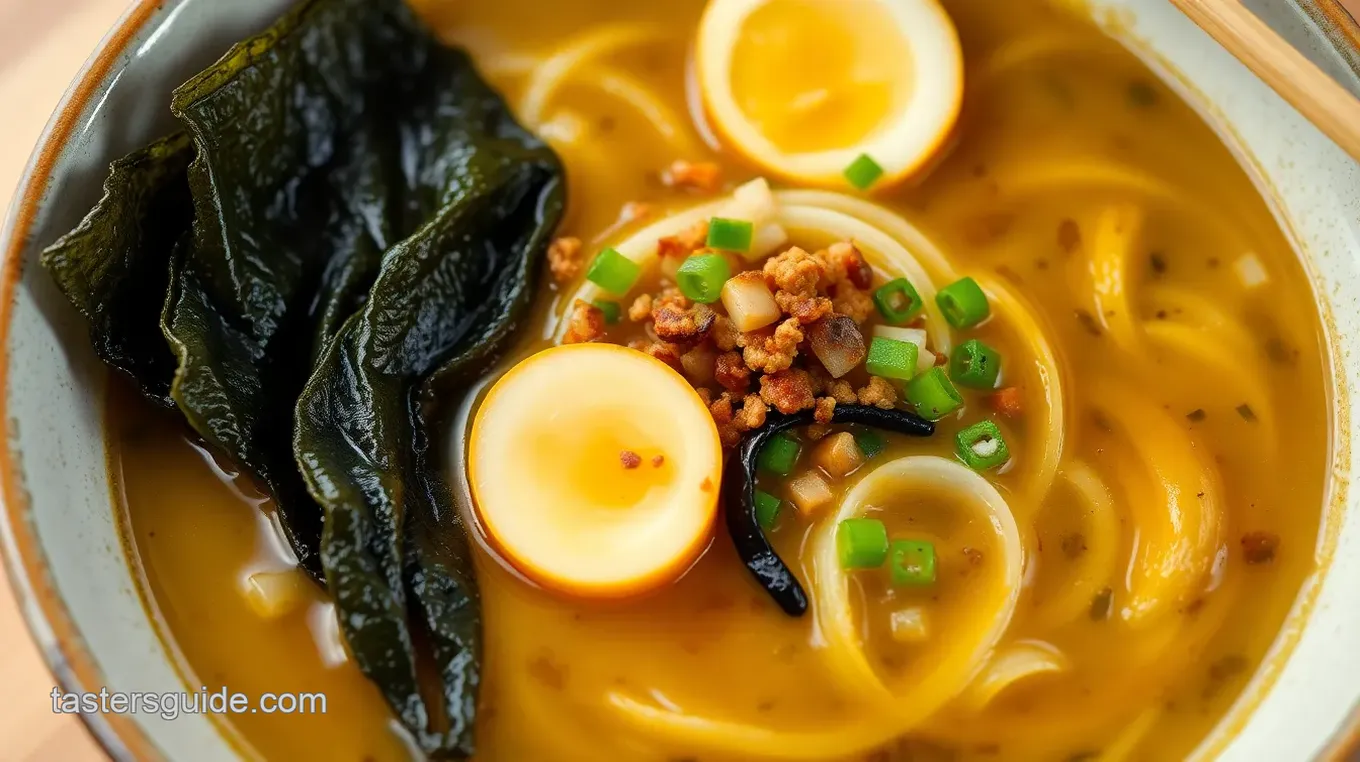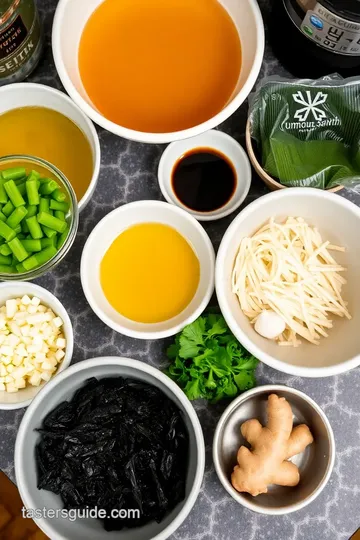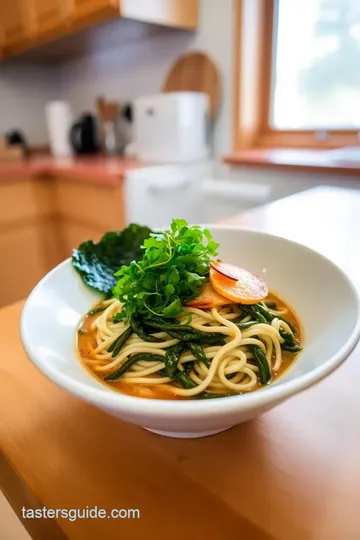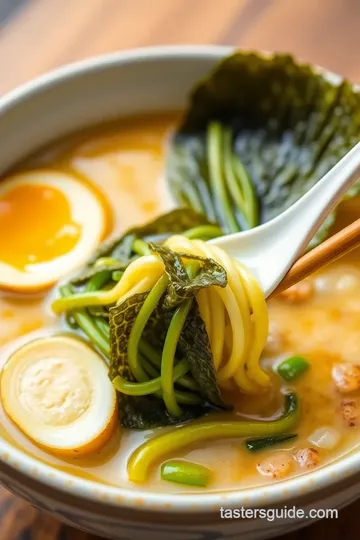Cook Algae Ramen: Tasty & Quick Delight
Looking for a quick yet delicious meal? My Cook Algae Ramen: Tasty & Quick Delight combines fresh belly-warming flavors that are perfect for any occasion!

- look into Into Flavor: Cook Algae Ramen — Tasty & Quick Delight
- Essential Ingredients Guide
- Professional Cooking Method: Mastering the Kitchen
- Pro Tips & Secrets
- Perfect Presentation
- Storage & Make-Ahead
- Creative Variations
- Complete Nutrition Guide
- Wrapping It Up
- Frequently Asked Questions
- Recipe Card
look into Into Flavor: Cook Algae Ramen — Tasty & Quick Delight
Oh my gosh, let me take you back to that one rainy evening when i discovered the magic of cook algae ramen .
I was watching my favorite cooking show, and the chef whipped up this vibrant bowl of seaweed ramen . at first, i thought, “is seaweed actually good for soup?” you know how we think of algae? well, little did i know, this nutrient-rich ramen would soon become my go-to comfort food! if you’ve ever looked for a quick and nourishing meal with that umami kick, you’re in the right spot.
A Taste of History in a Bowl
The roots of ramen run deep into japanese culture. it’s said that ramen originally came from china, but the japanese really made it their own.
I mean, who doesn’t love a good twist on culture? the love for ramen has only grown, especially when you think of quick weeknight meals that can be dressed up with fancy ramen toppings ideas or just enjoyed plain.
Nowadays, making your own version like this is not only popular but super easy.
When i first tried making this easy seaweed broth , i was shocked at how quickly it came together! we're talking about a total time of 25 minutes from start to finish, and trust me, it feels like a gourmet experience without the gourmet stress.
The difficulty level is easy , and i promise that if i can do it, you can too.
Oh, and bonus — this recipe is budget-friendly too! You can feed four people without breaking the bank, especially if you already have some garlic and ginger lying around.
Why Algae Ramen? Let’s Break It Down
Now, here’s the kicker: algae nutrition benefits are off the charts! algae, like wakame or nori, is packed with vitamins, minerals, and nutrients.
It’s a fantastic source of healthy proteins, which is great if you're looking for those vegan ramen options . plus, the flavors in this ramen are so rich; you’ll forget you’re eating a light and healthy meal .
If you’re hosting a dinner party, this dish is perfect! it’s fancy enough to impress, yet simple enough that you won’t be stuck in the kitchen while everyone else is having a good time.
You could swap in some spicy chili paste for those who like it hot or use a gourmet ramen at home approach by adding special garnishes like sesame seeds or soft-boiled eggs.
And let’s not forget when you're feeling a bit under the weather. Nothing warms you up like a bowl of flavorful vegetarian soup .
Time to Gather Ingredients!
So, are you ready to whip up this delicious bowl of comfort? Here’s what you'll need:
For the Broth:
- 4 cups vegetable broth
- 1 tablespoon soy sauce
- 2 teaspoons sesame oil
- 1 teaspoon grated fresh ginger
- 2 cloves garlic, minced
For the Ramen:
- 8 oz. ramen noodles (dried works too)
- 1 cup rehydrated algae
- 1 cup sliced shiitake mushrooms
- 1 cup baby spinach
- 2 green onions, thinly sliced
For Toppings:
- Soft-boiled eggs, if you're feeling fancy
- Sesame seeds for the garnish
- Extra soy sauce, always a good idea
Now grab those pantry essentials and get ready to impress yourself (and maybe your friends too)! this meal bursts with umami flavors , making it feel like a warm hug in a bowl.
Whether you’re diving into this as a quick Asian recipe for a busy weeknight or gearing up for a cozy weekend, I promise you’ll be coming back for more. Let’s get cooking!

Essential Ingredients Guide
Let’s kick things off with the must-have ingredients for our cook algae ramen: tasty & quick delight ! this dish isn't just about great taste; it's packed with nutrient-rich ramen goodness that you can whip up in no time.
Here’s the scoop on what you’ll need and how to make it shine.
Premium Core Components
When shopping for ingredients, it’s all about quality. You want the good stuff!
- Vegetable Broth : Go for a low-sodium version to control the flavor. 4 cups (960 ml) is what you need.
- Soy Sauce : Get the dark kind if you can—just 1 tablespoon (15 ml) adds a rich umami punch.
- Sesame Oil : A must for that distinct nutty flavor, requiring just 2 teaspoons (10 ml) .
- Fresh Ingredients : Grated ginger and minced garlic . Freshness is key! You’ll need 1 teaspoon (5 g) of ginger and 2 cloves of garlic.
Signature Seasoning Blend
Now, it’s time to jazz it up with flavors that make this dish sing.
- Algae Noodles : Use 8 oz (225 g) of either fresh or dried noodles; they absorb all that delicious broth goodness. Plus, they bring an awesome twist to your traditional noodle recipes!
- Shiitake Mushrooms : Opt for fresh if you can find them—those earthy flavors? Yes, please! 1 cup (150 g) and you’re golden.
- Spinach : A whole cup ( 100 g ) adds color and nutrients. It’ll wilt perfectly in the broth.
And don’t forget green onions for garnish! A thinly sliced 2 green onions , to top it off, taking your ramen aesthetics to the next level.
Smart Substitutions
Let’s talk alternatives for those last-minute pantry raids or dietary needs!
- Mushroom Swap : If shiitakes aren’t available, don’t sweat it! Button or cremini mushrooms work just as well.
- Vegan Plan : Skip the soft-boiled eggs for a pure plant-based experience.
- Rice Noodles : Need gluten-free? Trade in your ramen noodles for rice noodles; they’ll still rock that broth.
Kitchen Equipment Essentials
You don’t need a fancy kitchen to make this happen, but there are a few tools that can really save the day.
- Large Pot : For boiling up that comforting broth.
- Medium Pot : Perfect for the noodles. Let’s keep it simple.
- Colander : For draining the noodles easily (you don’t want soggy ramen).
- Knife and Cutting Board : Go for sharp, because nobody wants to battle a dull knife while prepping.
Putting It All Together
With all these handy ingredients and tools, you're ready to dive into this easy seaweed broth adventure! remember, you can play with flavors just as you would in any quick asian recipe .
Think of it as your canvas, and don’t be afraid to explore.
In just about 25 minutes , you’ll have a warm, hearty bowl of plant-based comfort food that screams flavor.
Imagine bringing friends over for a cozy night, serving up gourmet ramen at home with homemade broth that’ll have everyone raving about your chef skills.
Now, if you’re ready to embark on your flavor journey, let me show you the easy step-by-step instructions to bring this delicious dish alive on your dinner table.
Trust me, it’s going to be a hit!

Professional Cooking Method: Mastering the Kitchen
If you dream of creating dishes that rival your favorite asian restaurants, then it’s time to roll up your sleeves and dive into professional cooking methods.
Whether you're whipping up a cook algae ramen: tasty & quick delight or just trying to up your kitchen game, mastering the basics is key.
Essential Preparation Steps
Mise en Place Details
First things first, let’s talk mise en place , which basically means "everything in its place." before you even think about putting your pan on the stove, gather all your ingredients.
This way, when you start cooking, you won’t be scrambling around looking for that bottle of soy sauce. trust me, it’ll save you time and a whole lot of stress.
Plus, it’s super satisfying to see everything ready to go.
Time Management Tips
Timing is everything in cooking. when you’re making a quick asian recipe like ramen, you need to keep track of cooking times so nothing gets overcooked.
Set timers on your phone to remind you when to check your noodles or sauté your veggies. i often find myself singing in the kitchen but, when the timer goes off, it snaps me back to reality!
Organization Strategies
Keep things organized. use small bowls for prepped ingredients and don’t be afraid to stack them neatly. it makes your countertop look like a cooking show, plus it helps you keep everything visible.
Who knows, you might even impress your friends when they visit!
Safety Considerations
Cooking isn’t just about delicious food; it's also about safety. always keep a first aid kit handy. know how to handle knives properly and don’t forget about those pesky kitchen fires.
Have a fire extinguisher within reach, especially when you're cooking oils.
Step-by-Step Process
Clear, Numbered Instructions
Let’s get into the nitty-gritty of cooking. Take the Cook Algae Ramen recipe, for example. Be clear and concise in your steps. Always number them so you won’t miss a beat.
- Prepare your broth and let the flavors meld together over medium heat.
- While that's happening, boil your ramen noodles. Usually about 3- 4 minutes for fresh noodles.
- Add rehydrated algae and fresh veggies to the broth, stirring until tender for about 3- 4 minutes .
Temperature Control Points
Control your heat. For broth, you want a gentle simmer. If it’s boiling too hard, you’ll lose that beautiful flavor (and it might splatter, yikes!). Trust your instincts!
Timing Precision
Timing is your ally. When boiling those noodles, don’t wander off to scroll through social media. You’d be surprised how quickly they can go from perfect to mushy.
Visual Cues for Doneness
Learn to read your food. Noodles should be tender yet firm, and vegetables should be vibrant and bright. If it looks good, it probably tastes good!
Expert Techniques
Professional Methods
Use techniques you’ve seen chefs use. Ever noticed how they toss veggies in a pan? It’s all about getting that even cook without burning them. Try it out!
Critical Steps Explained
Always taste as you go, especially when developing your flavorful ramen broth . It helps you understand what’s missing—maybe a hint of salt or a splash of soy?
Quality Checkpoints
Check for freshness! Whether it’s your algae noodles or shiitake mushrooms, always inspect your ingredients.
Troubleshooting Tips
Sometimes, things don’t go according to plan. If your broth tastes bland, a dash of soy sauce might do the trick! Getting saucy can save the day.
Success Strategies
Common Mistakes to Avoid
Don’t overfill your pot with noodles or veggies. Stick to the recipe portions. It’s not a free-for-all—yet!
Quality Assurance Tips
Use the freshest ingredients you can find. Your healthy ramen ingredients will make all the difference. Nutrient-rich options like spinach not only taste great but look good too.
Perfect Results Guide
Want perfect broth? Let it simmer low and slow. For maximum flavor, simmer for at least 30 minutes . Trust me, it’s worth the wait!
Make-Ahead Options
Consider meal prep! ramen can be a fantastic quick weeknight meal, but that doesn’t mean you can’t plan ahead. make a big batch of broth and store it in the fridge; it’ll save you time during busy weeks.
Now that we've covered the basics, let’s chat about what’s next in your culinary journey! additional information on advanced techniques, specific ingredients, and exciting variations can give you the edge in creating those japanese-inspired dishes that will have your friends raving.
Cooking is not just about eating—it’s a journey. Embrace the process, and before you know it, you’ll be savoring your own homemade gourmet ramen at home!

Pro Tips & Secrets
Let’s kick things off with some of my favorite pro tips to take your Cook Algae Ramen: Tasty & Quick Delight to the next level!
First off, flavor is everything! for a deeper umami punch, consider adding a dash of miso paste to your broth while it simmers.
It’s a little trick i learned from a chef buddy who claims that miso is like the secret sauce for ramen lovers.
To save time, grab pre-sliced shiitake mushrooms or even some store-bought broth. seriously, sometimes tradition can take a backseat when you're in the kitchen on a crazy weeknight!
If you’re aiming for that instagram-ready ramen bowl, don’t ignore presentation. a sprinkle of sesame seeds on top adds that gourmet touch.
And hey, a little drizzle of soy sauce right before serving can jazz up the flavors even more. a splash just gets the taste buds dancing!
Perfect Presentation
Speaking of presentation, plating is a whole art form! start with the ramen noodles in the center of the bowl.
Then, carefully ladle your gorgeous broth around the noodles, making sure to include all those delicious veggies. the contrast of the deep color of seaweed and the bright green of baby spinach ? total eye candy!
For garnishes, slice up green onions and scatter them like confetti on top. oh, and those optional soft-boiled eggs? halve them and place them cut-side up for an alluring look.
As for color combos, think vibrant greens, earthy browns, and a splash of yellow from the eggs. it’s not just food; it’s a work of art!
Storage & Make-Ahead
Now, if you’re planning to meal prep, let’s talk about storage. the best way to keep everything fresh is to store your ramen noodles and broth separately.
This prevents the noodles from getting all mushy—which, let’s be honest, no one wants!
If you’re stashing leftovers, pop them in airtight containers. most of the ingredients will hold up in the fridge for up to 3 days .
When it's time to eat, just reheat the broth and then add those noodles— voila ! you have a quick and healthy meal ready in no time!
Creative Variations
Feeling adventurous? let’s switch things up! for a spicy twist, add a tablespoon of chili paste to your broth. want to keep it light? try tossing in some other seasonal veggies you have lying around, like bok choy or zucchini .
It’s all about using what you have and personalizing to your preference.
Don’t forget about dietary modifications—make it a full-on vegan treat by skipping the eggs or adding tofu for some extra protein.
You can even try different flavor adaptations , like miso or peanut sauce—trust me, that last one hits the spot!
Complete Nutrition Guide
Alright, let’s get real for a second. this isn’t just delicious; this dish is also packed with nutrients! each bowl is loaded with healthy ramen ingredients like algae , which is rich in vitamins and minerals.
You’re getting essential nutrients while enjoying a cozy meal.
Looking at a serving size, you’re bringing in about 320 calories with a solid balance of protein , fat , and fiber .
It’s the kind of comfort food that won’t weigh you down or make you feel guilty. portion control is key here; with a bowl like this, you’ll feel satisfied without overdoing it.
Wrapping It Up
So, there you have it! from pro tips to yummy vegan ramen options , i’m sure you’ll enjoy whipping up this cook algae ramen: tasty & quick delight as much as i do.
Whether you’re trying to impress friends, or just rescuing a weeknight dinner, this recipe checks all the boxes: tasty, simple, and absolutely satisfying.
Now, get in that kitchen and create your ramen masterpiece! you got this!
Frequently Asked Questions
What is the best way to cook algae ramen?
To cook algae ramen perfectly, follow the outlined steps in the recipe: start by preparing a flavorful broth, cook your ramen noodles separately, and then combine everything together. This method ensures that each component retains its flavor and texture, resulting in a delicious meal!
Can I customize the toppings for Cook Algae Ramen: Tasty & Quick Delight?
Absolutely! Customize your algae ramen with toppings like soft-boiled eggs, sliced chili, or additional vegetables like bok choy or carrots. This flexibility allows you to create a dish that suits your taste preferences and dietary restrictions.
How should I store leftovers from algae ramen?
For optimal freshness, store the noodles and broth separately in airtight containers in the fridge. This prevents the noodles from becoming soggy, and you can easily reheat the broth for a quick meal later!
What are the nutritional benefits of algae ramen?
Algae ramen is packed with health benefits, as algae is rich in vitamins, minerals, and antioxidants. Additionally, the dish includes nutrient-dense vegetables and can be customized to suit various dietary needs, making it a great choice for a balanced meal.
Can I make Cook Algae Ramen: Tasty & Quick Delight vegan?
Yes! To make this dish vegan, simply omit the soft-boiled eggs and ensure that all other ingredients, such as vegetable broth and soy sauce, are plant-based. You can still enjoy the umami flavor and nutritional benefits while adhering to a vegan diet.
What type of algae is best for this ramen dish?
You can use various types of dried algae, with wakame and nori being the most popular choices for ramen. These varieties rehydrate well and add a lovely sea flavor to the broth, enhancing the overall taste of your algae ramen.
Cook Algae Ramen: Tasty & Quick Delight Card

⚖️ Ingredients:
- 4 cups vegetable broth
- 1 tablespoon soy sauce
- 2 teaspoons sesame oil
- 1 teaspoon grated fresh ginger
- 2 cloves garlic, minced
- 8 oz ramen noodles (fresh or dried)
- 1 cup dried algae (such as wakame or nori), rehydrated
- 1 cup sliced shiitake mushrooms
- 1 cup baby spinach
- 2 green onions, sliced thinly
- Soft-boiled eggs (optional)
- Sesame seeds (for garnish)
- Extra soy sauce (to taste)
🥄 Instructions:
- Step 1: In a large pot, combine vegetable broth, soy sauce, sesame oil, ginger, and garlic. Bring the mixture to a simmer over medium heat.
- Step 2: In a medium pot, bring water to a boil. Add the ramen noodles and cook according to package instructions, usually about 3-4 minutes for fresh noodles. Drain and set aside.
- Step 3: To the simmering broth, add rehydrated algae, sliced shiitake mushrooms, and baby spinach. Cook for an additional 3-4 minutes until mushrooms are tender and spinach is wilted.
- Step 4: Divide cooked noodles among bowls. Ladle hot broth and vegetables over the noodles. Top with sliced green onions and soft-boiled eggs, if using.
- Step 5: Sprinkle with sesame seeds. Serve immediately, allowing each guest to add extra soy sauce to taste.
Previous Recipe: How to Make Baked Adobo Chicken Strips - Quick & Tasty!
Next Recipe: How to Make the Best Quick Papaya Sandwich with Creamy Spread
